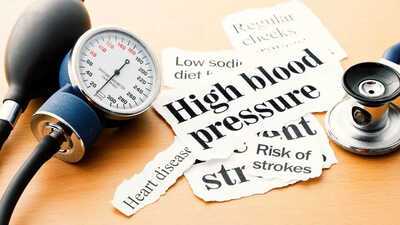Heavy lifting is often hailed as the ultimate way to build strength, muscles and boost performance. Many fitness experts believe heavy lifting delivers faster results. However, a shocking warning by a CMC Vellore trained physician and top neurologist Dr. Sudhir Kumar, has cautioned everyone. Dr. Sudhir warned that during maximal weight lifting, blood pressure can rise to extremely high levels and can even surpass beyond 300 mmHg, especially when techniques like the Valsalva maneuver are used. Even though this is a temporary spike, the effects of this surge can lead to different consequences for different individuals.
Dr. Sudhir Kumar also mentioned that controlled studies with experienced bodybuilders have documented average peak systolic pressures of 320 mmHg during double-leg press exercises.
A 1985 study found that during maximal double-leg press exercise, the mean peak systolic blood pressure was 320 mmHg, with one subject's reading exceeding 480 mmHg. The researchers noted that these extreme elevations were transient and returned to baseline levels shortly after the exercise concluded.
Similarly, a 1999 research observed that blood pressure increased progressively with each subsequent set of heavy resistance exercises. Peak systolic blood pressures were recorded as 238 mmHg in the first set, escalating to 293 mmHg by the third set, highlighting the cumulative cardiovascular stress during intense lifting sessions.
These studies also demonstrate that heavy resistance exercises, particularly those involving large muscle groups like the double-leg press, can induce significant and transient elevations in systolic blood pressure.
Why blood pressure spikes during heavy lifting
During heavy resistance training, particularly maximal lifts, the body undergoes significant cardiovascular stress. As per studies, one of the primary contributors to sudden spikes in blood pressure during such exercises is the Valsalva maneuver. When performing the Valsalva maneuver, intra-abdominal and intrathoracic pressures increase sharply, which helps stabilize the spine and provides a solid base for lifting heavy weights. However, this same pressure compresses major blood vessels, temporarily reducing venous return to the heart. As a result, the heart must work harder to pump blood through a partially restricted circulatory system, causing systolic blood pressure to spike dramatically.
Who might face serious risks
In his post, neurologist Dr. Sudhir adds, in a healthy person, with normal heart functions, this transient rise in BP does not lead to any adverse health issues. BP returns to normal levels soon after the exercise is over. However, the combination of high intrathoracic pressure and elevated BP means that individuals with pre-existing cardiovascular conditions, uncontrolled hypertension, or vascular abnormalities may face higher risks during these maneuvers.

Even for healthy individuals, it is essential to practice proper breathing techniques and avoid breath-holding to minimize unnecessary strain on the cardiovascular system.
Transient warning signs of high blood pressure may include sudden or severe headaches, dizziness or lightheadedness, blurred vision, shortness of breath, chest pain or tightness, and even unexplained nosebleeds. Regular blood pressure monitoring, both at rest and during exercise when advised, is important to detect dangerous elevations early.
Some recommendations for safe lifting
For individuals at risk of extreme surge in blood pressure, there are several safer alternatives that can still build strength, improve fitness, and support overall health without the extreme BP spikes. Brisk or moderate walking, biking or cycling or swimming can offer safe and effective options for managing and lowering blood pressure.
Did you know that BP can increase to >300 mmHg (though for a short time) during maximal weight lifting?
— Dr Sudhir Kumar MD DM (@hyderabaddoctor) October 12, 2025
✅Yes, systolic blood pressure can rise to extremely high levels, sometimes beyond 300 mmHg, during maximal weight lifting, especially when techniques like the Valsalva… pic.twitter.com/RhHbUxCDtp
Dr. Sudhir Kumar also mentioned that controlled studies with experienced bodybuilders have documented average peak systolic pressures of 320 mmHg during double-leg press exercises.
A 1985 study found that during maximal double-leg press exercise, the mean peak systolic blood pressure was 320 mmHg, with one subject's reading exceeding 480 mmHg. The researchers noted that these extreme elevations were transient and returned to baseline levels shortly after the exercise concluded.
Similarly, a 1999 research observed that blood pressure increased progressively with each subsequent set of heavy resistance exercises. Peak systolic blood pressures were recorded as 238 mmHg in the first set, escalating to 293 mmHg by the third set, highlighting the cumulative cardiovascular stress during intense lifting sessions.
These studies also demonstrate that heavy resistance exercises, particularly those involving large muscle groups like the double-leg press, can induce significant and transient elevations in systolic blood pressure.
Why blood pressure spikes during heavy lifting
During heavy resistance training, particularly maximal lifts, the body undergoes significant cardiovascular stress. As per studies, one of the primary contributors to sudden spikes in blood pressure during such exercises is the Valsalva maneuver. When performing the Valsalva maneuver, intra-abdominal and intrathoracic pressures increase sharply, which helps stabilize the spine and provides a solid base for lifting heavy weights. However, this same pressure compresses major blood vessels, temporarily reducing venous return to the heart. As a result, the heart must work harder to pump blood through a partially restricted circulatory system, causing systolic blood pressure to spike dramatically.
Who might face serious risks

In his post, neurologist Dr. Sudhir adds, in a healthy person, with normal heart functions, this transient rise in BP does not lead to any adverse health issues. BP returns to normal levels soon after the exercise is over. However, the combination of high intrathoracic pressure and elevated BP means that individuals with pre-existing cardiovascular conditions, uncontrolled hypertension, or vascular abnormalities may face higher risks during these maneuvers.
- Individuals with hypertension: Those with pre-existing high blood pressure may experience exaggerated BP responses during intense lifting.
- Older adults: Age-related changes in vascular elasticity can increase the risk of complications during heavy lifting.
- Individuals with heart conditions: Conditions like arrhythmias or heart disease can be exacerbated by significant BP fluctuations.
- Untrained individuals: Lack of conditioning can lead to improper technique and increased cardiovascular strain.
Even for healthy individuals, it is essential to practice proper breathing techniques and avoid breath-holding to minimize unnecessary strain on the cardiovascular system.
Transient warning signs of high blood pressure may include sudden or severe headaches, dizziness or lightheadedness, blurred vision, shortness of breath, chest pain or tightness, and even unexplained nosebleeds. Regular blood pressure monitoring, both at rest and during exercise when advised, is important to detect dangerous elevations early.
Some recommendations for safe lifting
- Use controlled breathing techniques, exhaling during the exertion phase of the lift.
- Increase weights incrementally to allow the body to adapt to higher intensities.
- Engage in light aerobic exercises and dynamic stretches before lifting to prepare the cardiovascular system.
- Individuals with known cardiovascular issues should regularly check their BP and consult healthcare providers before engaging in intense lifting sessions.
For individuals at risk of extreme surge in blood pressure, there are several safer alternatives that can still build strength, improve fitness, and support overall health without the extreme BP spikes. Brisk or moderate walking, biking or cycling or swimming can offer safe and effective options for managing and lowering blood pressure.
You may also like

Horror as trailer collides with pram - three kids rushed to hospital

Lalu IRCTC scam 'fountainhead', says court as it frames charges

Gaza deal: Trump signs peace plan, hostages exchanged, Israeli troops return — what's next?

National Commission for Women flags lapses, seeks fast-track trial

Governer: Don't have confidence to say West Bengal is safe






